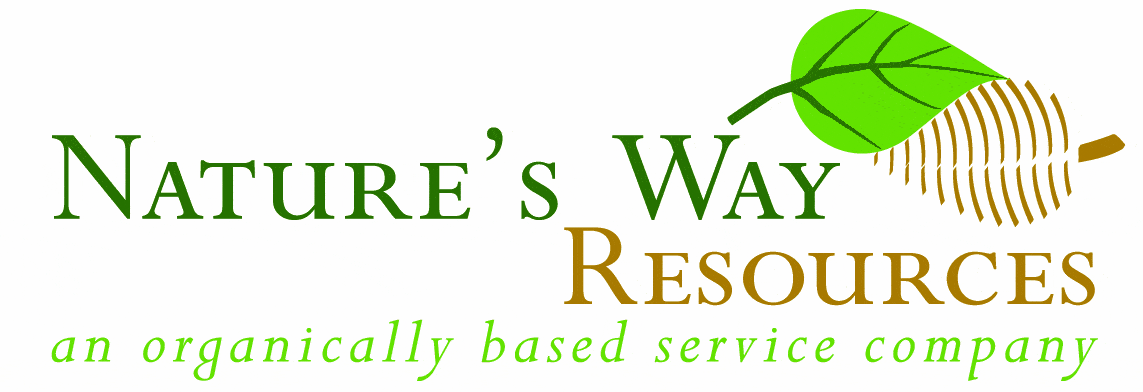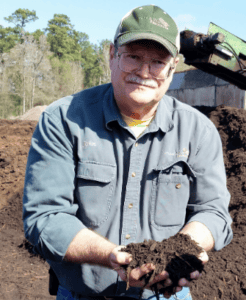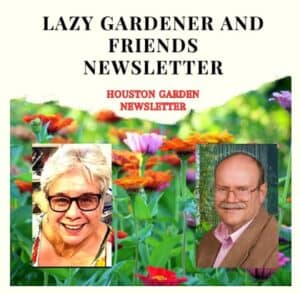 Nature’s Way Resources is proud to produce & email you this free weekly newsletter. We have no ads, but sponsors do graciously help support this project as a public service. Please note their names below & show your gratitude for this free service by patronizing their businesses! To become a sponsor, call (936) 273-1200
Nature’s Way Resources is proud to produce & email you this free weekly newsletter. We have no ads, but sponsors do graciously help support this project as a public service. Please note their names below & show your gratitude for this free service by patronizing their businesses! To become a sponsor, call (936) 273-1200
Nature’s Way Resources owner John Ferguson, “The Lazy Gardener” Brenda Beust Smith and Pablo Hernandez welcome your feedback and are so grateful to the many horticulturists who contribute their expertise
Click here to join our email list
CLICK HERE for PDFs OF PAST LG&F NEWSLETTERS
“Apologies to horticulturists & serious native plant enthusiasts. YOU can probably identify these! But lot of folks can’t & it’s nicer to have a name, even a funny one!”
— Brenda

Just a few of Texas’s (seemingly) thousands of yellow “DYC” wildflowers:
l to r: Stonecrop (Sedum), Parralena (Dyssodia pentachaeta) and Brown-eyed Susan (Rudbeckia hirta).
GREAT YEAR FOR ‘DYCs’ & OTHER NOTABLES
BY BRENDA BEUST SMITH
March 12 was National Plant a Flower Day. Even if you missed it, never to late to plant a DYC! Lately received several “what is this?” pictures from readers — not surprising since spring is by far the best season in years for many DYCs. Most are great for home planting because . .
- Yellow flowers are recommend for uneven walkways. Why?
- Yellow immediately draws the eye, usually faster than any other color.
- Every spring they blanket fields, medians, freeway strips and vacant lots.
- For me, DYCs recall fond memories of the late Carmine Stahl, famous edible native plant expert, author of “Trees of Texas” (Texas A&M Press).
One day, as I followed Carmine around for an edible weeds interview, I spied a beautiful yellow wildflower. “What is that?” “DYC,” he said. Farther on, spotted other totally different yellow bloomers. Repeatedly, Carmine answered, “DYC.” Finally asked, “What’s a DYC?” Carmine smiled and said:
“Damn Yellow Composite!”
 Carmine didn’t invent this nickname. It’s on Wikipedia: “ …any yellow flower in the family Asteraceae.” The sexually-active little plants cross so easily, they may even stump experts. I figure if the DYC’s good enough for someone as renowned as Carmine Stahl to use, it’s good enough for me.
Carmine didn’t invent this nickname. It’s on Wikipedia: “ …any yellow flower in the family Asteraceae.” The sexually-active little plants cross so easily, they may even stump experts. I figure if the DYC’s good enough for someone as renowned as Carmine Stahl to use, it’s good enough for me.
Over the years, I transplanted a lot of DYCs into my own yard. They stayed perky-pretty for a long time after transplanting, ideal for making gardens look gorgeous for parties!
Problem is, when not in bloom, most look like truly sad weeds. I’d forget where I put them and kept pulling them or smothering them under heavy mulch. Some never returned for me. But some did!

L to r, vitex, magnolia and a (DON’T PLANT!) mimosa
SEEN ‘ROUND TOWN: Start looking for purple-spike-flowered vitex trees. Ditto for magnolias, with their pure white flowers.
Both vitex and magnolias now come in dwarf varieties, amazingly with the same-size magnificent flowers as on their standard size “parents.” “Dwarf” magnolias are favorites for commercial and home landscapes alike. You’ll still see gorgeous mimosa (right) around town but please, DON’T PLANT!
Unfortunately, as pretty as mimosas are, with our changing climate. like many other gorgeous favorites-of-old (purple wisteria’s another ‘Please don’t plant!)), mimosas have become dangerously invasive, destroying native habitat vital to local flora and fauna. Don’t plant any new ones. Nature’s warning us. We better start listening.
SAGE VS SALVIA – KNOW THE DIFFERENCE? Generally speaking, “Salvia” (botanical genus name) is the “group” name for both. But it’s also used for ornamentals. Sage” typically refers to the specific culinary herb within the Salvia genus, All sage plants are considered salvias. Some are edible, some NOT, Texas purple sage is not. Do your research!

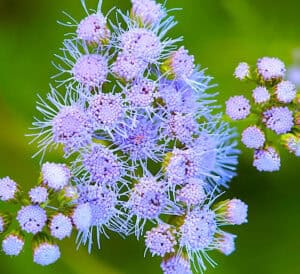 GREGG’S MISTFLOWER Conoclinium greggii) is LADY BIRD JOHNSON WILDFLOWER CENTER’s 2025 TEXAS WILDFLOWER OF THE YEAR . This fuzzy purple bloomer is tough, drought-tolerant, easy to grow, and supports pollinators, especially Queens and Monarchs. Blooms from March through November, providing a steady parade of winged visitors. .
GREGG’S MISTFLOWER Conoclinium greggii) is LADY BIRD JOHNSON WILDFLOWER CENTER’s 2025 TEXAS WILDFLOWER OF THE YEAR . This fuzzy purple bloomer is tough, drought-tolerant, easy to grow, and supports pollinators, especially Queens and Monarchs. Blooms from March through November, providing a steady parade of winged visitors. .
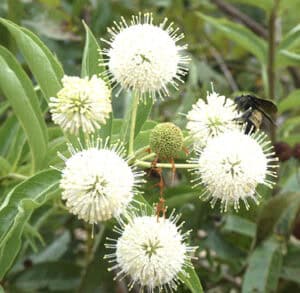 TREES FOR HOUSTON IS TOUTING Texas’ (and Houston’s) native Buttonbush (Cephalanthus occidentalis), a shrub or small tree with unique, mid-summer, globe-shaped white flowers. Often called “buttonball” or “honeyball,” buttonbush attracts bees, butterflies, and hummingbirds. Typically 6′-12′ (tall & wide) with similar spread, thrives in moist, well-drained soils.
TREES FOR HOUSTON IS TOUTING Texas’ (and Houston’s) native Buttonbush (Cephalanthus occidentalis), a shrub or small tree with unique, mid-summer, globe-shaped white flowers. Often called “buttonball” or “honeyball,” buttonbush attracts bees, butterflies, and hummingbirds. Typically 6′-12′ (tall & wide) with similar spread, thrives in moist, well-drained soils.
Commonly found in wetland areas, buttonbush tolerates some drought once established, full sun/part shade. Winter bird food. Trees for Houston is looking for new members & SITES (!) to host free tree-giveaways to increase the already–700,000 trees planted in Houston area. At this point, local local research show, Houston is losing more trees than we’re planting.This definitely affects our utility bills! (Don’t miss John’s fascinating, more-informative notes on butterflies below!)
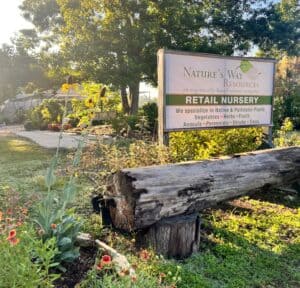 ATTN. GARDEN/PLANT GROUPS — In wake of Hurricane Beryl, Nature’s Way Resources offers free guided tours of NWR’s extensive nursery/soil/mulch facilities for garden clubs, plant societies and other plant-oriented, organized groups. As usual, NWR’s now-expanded meeting site is free to above groups. Reservations a must for both.
ATTN. GARDEN/PLANT GROUPS — In wake of Hurricane Beryl, Nature’s Way Resources offers free guided tours of NWR’s extensive nursery/soil/mulch facilities for garden clubs, plant societies and other plant-oriented, organized groups. As usual, NWR’s now-expanded meeting site is free to above groups. Reservations a must for both.
Brenda Beust Smith’s column is based on her 40+ years as the Houston Chronicle’s “Lazy Gardener” column — lazygardenerbrenda@gmail.com Brenda’s column focuses ONLY on the Greater Houston Area
John’s Corner
NEWS FROM THE WONDERFUL WORLD
OF SOIL AND PLANTS
Subject: Butterflies fire regeneration fluoride
A paper recently published in the journal Science found that our butterfly population continues to decrease, another 22% in the last 20 years with Texas having one of the largest declines.
There are many reasons for this decline, such as habitat loss and toxic chemicals. Another issue is genetically modified flowers (and crops) that produce their own poisons. Many flowers have been hybridized to produce more and larger flowers but in the process the quality of their pollen and nectar also declined, providing less nourishment leading to more disease and less reproduction.
Researchers have found that bees, butterflies and other pollinators need a healthy diet. This is a mix of proteins, lipids, amino acids, omega 3 and omega 6 acids, and some other essential nutrients along with micro nutrients. They get these nutrients from the pollen and nectar they consume. However, if they consume them in the wrong ratios the insects experience cognitive decline (bees are a good example), and they may become more susceptible to parasites.
The researchers measured the nutrient profile of 57 species of flowers common to North America and the nutrient profile varied greatly. To be healthy the bees and butterflies must consume pollen and nectar from a large diversity of flowers. Journal of Sustainable Food Systems (2024)
After reading the paper I remembered a test I did over 30 years ago comparing the number of pollinators on a sunflower species. I planted two rows, each six foot wide by fifty foot long and planted them with two different versions of the Mexican sunflower (tithonia sp.). One seed source was open-pollinated, and the other was a cultivar bred for even sized stalks and flowers.
We took several photos of both flower beds. We were able to count over 80 butterflies (numerous bees and other insects too small to count) feeding on the open-pollinated variety and Zero butterflies on the cultivar!
Another variable is that soil without trace and micro-nutrients will not grow plants with these essential elements in the pollen and nectar hence this is another factor contributing to malnutrition.
Most of us are aware the certain butterflies like the Monarch only lay their eggs on Milkweeds. Many species of butterflies have evolved to lay their eggs on only one or a very few species of plants. If these plants are not available, then the butterflies cannot reproduce hence contributing to the decline.
So, what can a gardener do? Use modern organic methods (no toxic chemicals), plant native plants both shrubs and trees that are host plants for caterpillars, plant heirloom and open pollinated plants that produce higher quality nectar and pollen, in addition to organic fertilizer and a good compost, keep the soil remineralized by adding some trace minerals every few years to one’s flower beds.
The Nature Conservancy had a nice article and video on the benefits of prescribed fire to restore landscapes. Many of our readers have large lots or homes in the country where fire can be a powerful tool to help heal our land.
How We Work with Fire in Texas – Managing and restoring Texas’ landscapes with prescribed fire.
I finished reading a good book the other day:
Regeneration – Ending the climate crisis in one generation, by Paul Hawken, Penguin Books, 2021, ISBN: 978-0143136972
It talks about how mankind created climate issues and how we can as a global society quickly correct the damage to the environment if we choose to.
From the publisher: “Regeneration offers a visionary new approach to climate change, one that weaves justice, climate, biodiversity, equity, and human dignity into a seamless tapestry of action, policy, and transformation that can end the climate crisis in one generation. It is the first book to describe and define the burgeoning regeneration movement spreading rapidly throughout the world.
Regeneration describes how an inclusive movement can engage the majority of humanity to save the world from the threat of global warming, with climate solutions that directly serve our children, the poor, and the excluded. This means we must address current human needs, not future existential threats, real as they are, with initiatives that include but go well beyond solar, electric vehicles, and tree planting to include such solutions as the fifteen-minute city, bioregions, azolla fern, food localization, fire ecology, decommodification, forests as farms, and the number one solution for the world: electrifying everything.
Paul Hawken and the nonprofit Regeneration Organization are launching a series of initiatives to accompany the book, including a streaming video series, curriculum, podcasts, teaching videos, and climate action software. Regeneration is the inspiring and necessary guide to inform the rapidly spreading climate movement.”
One point made in the book is that over one third of our climate change is caused by the toxic chemical rescue agriculture making it the single largest contributor to global warming. To quote “today’s food system has become the single greatest cause of global warming, soil loss, chemical poisoning, chronic diseases, rain forest destruction, and dying oceans.” Worldwide big Ag dumps nine billion pounds of poison into the environment each year!
Good news on the health front. We have talked about the dangers of fluoride to plants, animals, and our children many times in this newsletter.
The state of Utah has passed a law banning fluoride from public water systems. The states of Florida, Montana, and Tennessee have similar laws pending in their legislatures.
The evidence that fluoride is toxic and harms our children and the environment has become overwhelming. It is nice to see states starting to protect the public. For those who wish to consume fluoride it is available in tablet form from many sources.
SPONSORSHIP
If you are interested in becoming a sponsor, please contact us at 936-273-1200 or send an e-mail to: lazygardenerandfriends@gmail.com
ABOUT US
BRENDA BEUST SMITH WE KNOW HER BEST AS THE LAZY GARDENER . . .
- but Brenda Beust Smith is also:
- a national award-winning writer & editor
- a nationally-published writer & photographer
- a national horticultural speaker
- a former Houston Chronicle reporter
When the Chronicle discontinued Brenda’s 45-year-old Lazy Gardener” print column — started in the early ’70s as a fun side-project to reporting, it then ranked as the longestrunning, continuously-published local newspaper column in the Greater Houston area. The name, she says, is not just fun, it’s true.
Brenda’s gradual sideways step from reporter into gardening writing led first to an 18-year series of when-to-do-what Lazy Gardener Calendars, then to her Lazy Gardener’s Guide book which morphed into her Lazy Gardener’s Guide on CD, which she now emails free upon request.
Brenda became a Harris County Master Gardener and, over the years, served on theboards of many Greater Houston area horticulture organizations. She hosted local radio and TV shows, most notably a 10+-year Lazy Gardener specialty shows on HoustonPBS (Ch. 8) and her call-in “EcoGardening” show on KPFT-FM.
For over three decades, Brenda served as Assistant Production Manager of the GARDEN CLUB OF AMERICA’S “BULLETIN” magazine. Although still an active broad-based freelance writer, Brenda’s main focus now is THE LAZY GARDENER & FRIENDS HOUSTON GARDEN NEWSLETTER with John Ferguson and Pablo Hernandez of Nature’s Way Resources.
A native of New Orleans and graduate of St. Agnes Academy and the University of Houston, Brenda lives in Humble, TX, and is married to the retired Aldine High School Coach Bill Smith. They have one son, Blake.
Regarding this newsletter, Brenda is the lead writer, originator of it and the daily inspiration for it. We so appreciate the way she has made gardening such a fun way to celebrate life together for such a long time.
About her column, Brenda says: “I don’t consider myself a ‘garden writer.” I started out 50+ years ago as a very lazy “gardening reporter.” I still feel that way today. I hope my columns inspire/help newcomers, but I do not write to them. I write to very experienced gardeners who want to expand their horizons.
JOHN FERGUSON
John is a native Houstonian and has over 35 years of business experience. He owns Nature’s Way Resources, a composting company that specializes in high quality compost, mulch, and soil mixes. He holds a MS degree in Physics and Geology and is a licensed Soil Scientist in Texas.
John has won many awards in horticulture and environmental issues. For years he represented the composting industry on the Houston-Galveston Area Council for solid waste. His personal garden has been featured in several horticultural books and “Better Homes and Gardens” magazine. His business has been recognized in the Wall Street Journal for the quality and value of their products. He is a member of the Physics Honor Society and many other professional societies. John is the co-author of the book Organic Management for the Professional.
For this newsletter, John contributes articles regularly and is responsible for publishing it.
PABLO HERNANDEZ Pablo Hernandez is the special projects coordinator for Nature’s Way Resources. His realm of responsibilities include: serving as a webmaster, IT support, technical problem solving/troubleshooting, metrics management and quality control. Pablo helps this newsletter happen from a technical support standpoint.
Download the Newsletter with Our Events Calendar Below!
